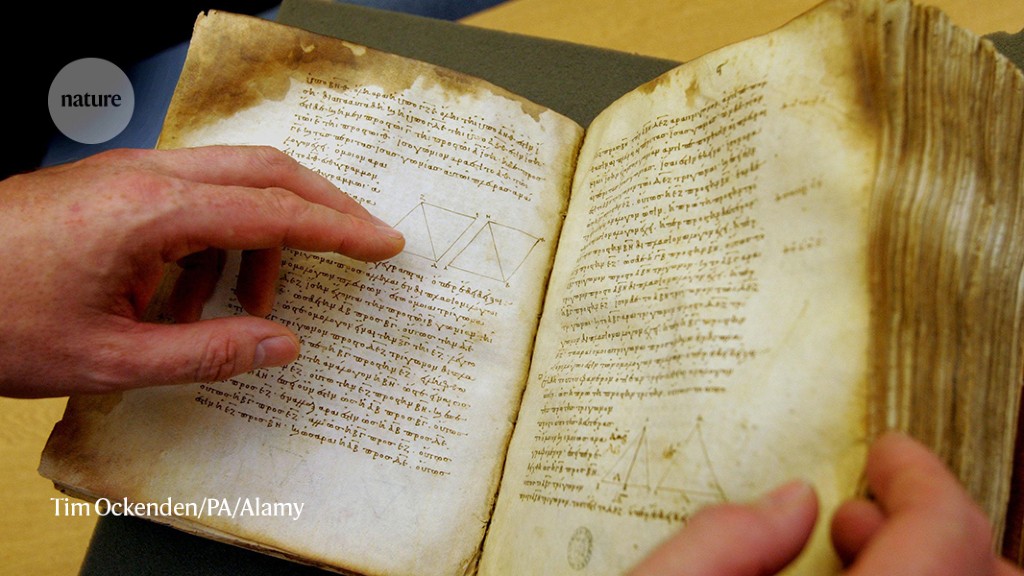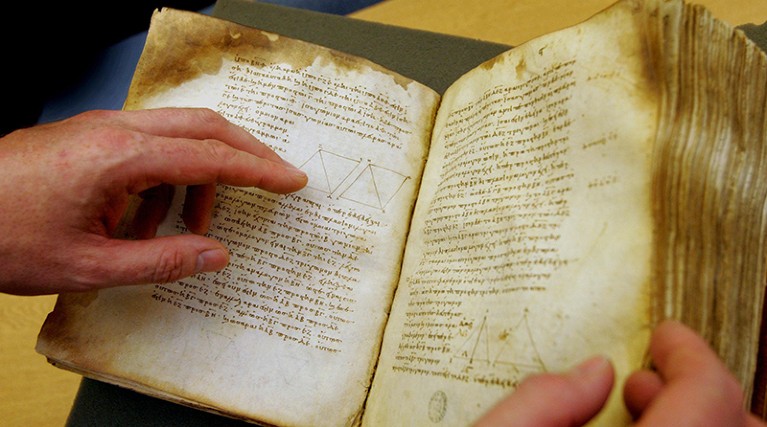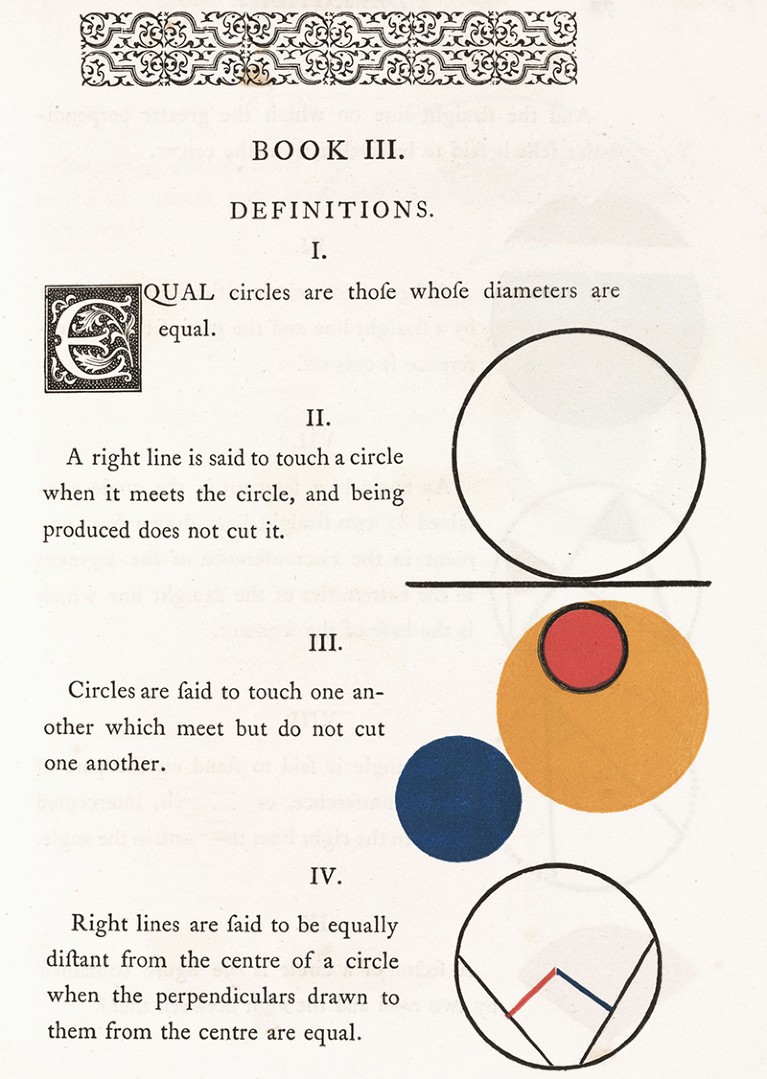Euclid’s Elements provided the basis for mathematics.Credit: Tim Ockenden/PA/Alamy
Axiomatics: Mathematical Thought and High Modernism Alma Steingart Univ. Chicago Press (2022)
The work of mathematicians from centuries or even millennia ago speaks to their living peers in ways that practitioners of other disciplines must find baffling. Euclid’s proof that the list of prime numbers never ends is just as elegant and clear now as it was in around 300 bc, when it appeared in his book Elements.
Yet mathematics has undergone tremendous changes, especially during the twentieth century, when it pushed ever deeper into the realm of abstraction. This upheaval even involved a redefinition of the definition itself, as Alma Steingart explains in Axiomatics.
A historian of science, Steingart sees this revolution as central to the modernist movements that dominated the mid-twentieth century in the arts and social sciences, particularly in the United States. Mathematicians’ push for abstraction was mirrored by — and often directly triggered — parallel trends in economics, sociology, psychology and political science. Steingart quotes some scientists who saw their liberation from merely explaining the natural world as analogous to how abstract expressionism freed painting from the shackles of reality.
Maths classification is getting a revision
The mathematics encapsulated in Euclid’s Elements started from foundational truths called axioms and built up statements through logical deductions. To Euclid, axioms such as ‘any straight segment can be extended to an infinite line’ were self-evident because they were rooted in physical reality.
For centuries, Western culture revered Elements as the paragon of intellectual rigour. In the seventeenth century, political theorist Thomas Hobbes referred to the book as ‘a structural model of a stable society’ and philosopher Baruch Spinoza adopted its structure of axioms and deductions in his treatise on ethics. The Catholic Church, meanwhile, held Euclid’s work as dogma, a way to anchor itself amid what it considered the anarchy brought about by the Protestant Reformation (as well as to protect it from the revolutionary threat of ‘infinitesimally small’ numbers introduced in calculus, as Amir Alexander explains in his intriguing 2014 book Infinitesimal).
Diverging worlds
Modern mathematics turns Euclid’s principle of axioms derived from physical reality on its head. Mathematicians might follow their creative impulses to come up with any set of axioms they wish — inventing, for example, non-Euclidean geometries in which parallel lines converge or diverge.
In this conception, creating a mathematical theory is similar to setting the rules of a game such as chess, in which the names, shapes and roles of the pieces are purely a matter of convention. Just as someone can begin with the rules of chess and a given configuration of the board and arrive at a prediction of ‘checkmate in five moves’, a mathematician can start from axioms and go through a sequence of logical steps to prove the truth of a theorem, without worrying what reality it represents.
Euclid’s geometry was rooted in reality — but modern mathematics is less constrained.Credit: SSPL/Getty
To the mathematical-theory builder, abstraction is not a destination, but a journey. As Steingart puts it, ‘abstract’ is not an adjective but a verb: ‘to abstract’. In the 1930s, owing largely to the influence of German mathematician Emmy Noether, mathematicians began to construct axiomatic systems that were increasingly abstract and general. This revealed familiar objects such as numbers, card shuffles and geometrical symmetries to be special cases of the same concept.
The trend towards abstraction and generalization is often associated with a school of mathematics that blossomed in France after the Second World War. But, as Steingart shows, it took root in the 1930s in the United States and came to define the country’s mid-century mathematical culture. Steingart exemplifies the trend with the story of Foundations of Algebraic Topology, a 1952 book by US mathematicians Samuel Eilenberg and Norman Steenrod. It dealt with various calculation techniques to distinguish between geometric shapes, but the authors introduced the subject backwards, claiming that students should first familiarize themselves with highly technical algebraic tools and only later learn their relevance to shapes, or why the tools existed in the first place.
The strange topology that is reshaping physics
A central thesis in Axiomatics is that US mathematicians saw the process of abstraction and generalization not as antithetical to the real world, but as crucial to how maths — or, rather, mathematical thinking — can be applied to practical problems. ‘Mathematizing’ a problem did not mean to measure and compute, but to reveal a hidden skeleton of conceptual relationships: to formulate the underlying idea in abstract mathematical language.
Often, this meant not applying existing mathematical concepts, but inventing new ones. An influential example was the 1944 book Theory of Games and Economic Behavior, which established modern game theory and included very non-playful implications for strategies of nuclear defence. By retracing an impressive web of connections, Steingart shows how the authors, the US mathematician John von Neumann and the German economist Oskar Morgenstern, not only helped to define the relationship between science and politics during the cold war, but also provided a model for further attempts at mathematization in the social sciences.
Taken to excess
Ironically, even as some mathematicians argued that abstract thinking was the key to applying maths to other disciplines — and suggested that even the most abstract maths was worthy of public funding — most mathematicians in academia seemed singularly uninterested in getting involved. For decades, much of the progress in applied mathematics ended up taking place not in universities, but in think tanks and industry laboratories, or in newly established departments devoted to fields such as computer science or statistics.
Eventually, an excess of abstraction caught up with mathematicians. Steingart sketches how the latter parts of the twentieth century saw a turning of the tide: she picks the example of William Thurston, an enormously influential topologist who delighted in making his complex geometric constructions feel physically real.
One major development she does not touch on is a renewed cross-fertilization with theoretical physics in the late twentieth century. This includes the application of topology to innovations such as ‘topological’ materials — which could even form a basis for super-powerful quantum computers — and the development of string theory, which might not have given physicists their long-sought theory of everything, but has inspired many a maths PhD thesis. And there is some anecdotal evidence that in the past decade or so, the barriers between pure and applied mathematics have started to drop: it is not uncommon now to see researchers from the most abstract reaches of the field ‘getting their hands dirty’ with applications such as data analysis.
Meanwhile, Eilenberg and Steenrod’s approach to pedagogy came to be seen as a cautionary tale, with their techniques, although still widely used, affectionately being called ‘abstract nonsense’. But in another of the twists of fate often seen in the history of maths and physics, some physicists now consider abstract-nonsense techniques a promising approach to devising a quantum theory of gravity — perhaps delivering another route to the very real, if abstract, goal of a theory of everything.











More News
Star Formation Shut Down by Multiphase Gas Outflow in a Galaxy at a Redshift of 2.45 – Nature
Garden-variety fungus is an expert at environmental clean-ups
Air-travel climate-change emissions detailed for nearly 200 nations